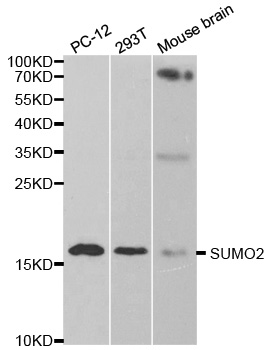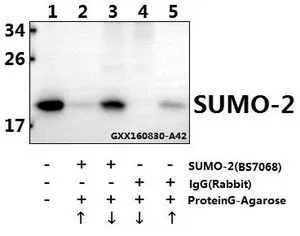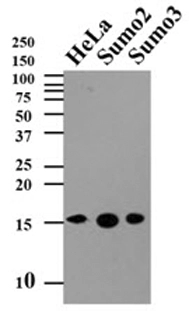![IHC-P analysis of human testicular carcinoma tissue using GTX35095 SUMO2 antibody [SUMO2/1199]. IHC-P analysis of human testicular carcinoma tissue using GTX35095 SUMO2 antibody [SUMO2/1199].](https://www.genetex.com/upload/website/prouct_img/normal/GTX35095/GTX35095_20200115_IHC-P_1212_w_23060801_954.webp)
IHC-P analysis of human testicular carcinoma tissue using GTX35095 SUMO2 antibody [SUMO2/1199].
SUMO2 antibody [SUMO2/1199]
GTX35095
ApplicationsFlow Cytometry, ImmunoFluorescence, ImmunoCytoChemistry, ImmunoHistoChemistry, ImmunoHistoChemistry Paraffin
Product group Antibodies
TargetSUMO2
Overview
- SupplierGeneTex
- Product NameSUMO2 antibody [SUMO2/1199]
- Delivery Days Customer9
- Application Supplier NoteICC/IF: 1-2microg/ml. IHC-P: 1-2microg/ml for 30 minutes at RT. FACS: 1-2microg/106 cells. *Optimal dilutions/concentrations should be determined by the researcher.Not tested in other applications.
- ApplicationsFlow Cytometry, ImmunoFluorescence, ImmunoCytoChemistry, ImmunoHistoChemistry, ImmunoHistoChemistry Paraffin
- CertificationResearch Use Only
- ClonalityMonoclonal
- Clone IDSUMO2/1199
- Concentration0.2 mg/ml
- ConjugateUnconjugated
- Gene ID6613
- Target nameSUMO2
- Target descriptionsmall ubiquitin like modifier 2
- Target synonymsHSMT3, SMT3B, SMT3H2, SUMO3, Smt3A, small ubiquitin-related modifier 2, SMT3 homolog 2, SMT3 suppressor of mif two 3 homolog 2, sentrin 2, ubiquitin-like protein SMT3A, ubiquitin-like protein SMT3B
- HostMouse
- IsotypeIgG1
- Protein IDP61956
- Protein NameSmall ubiquitin-related modifier 2
- Scientific DescriptionThis gene encodes a protein that is a member of the SUMO (small ubiquitin-like modifier) protein family. It functions in a manner similar to ubiquitin in that it is bound to target proteins as part of a post-translational modification system. However, unlike ubiquitin which targets proteins for degradation, this protein is involved in a variety of cellular processes, such as nuclear transport, transcriptional regulation, apoptosis, and protein stability. It is not active until the last two amino acids of the carboxy-terminus have been cleaved off. Numerous pseudogenes have been reported for this gene. Alternate transcriptional splice variants, encoding different isoforms, have been characterized. [provided by RefSeq, Jul 2008]
- Storage Instruction-20°C or -80°C,2°C to 8°C
- UNSPSC12352203

![IHC-P analysis of human tonsil tissue using GTX35095 SUMO2 antibody [SUMO2/1199]. IHC-P analysis of human tonsil tissue using GTX35095 SUMO2 antibody [SUMO2/1199].](https://www.genetex.com/upload/website/prouct_img/normal/GTX35095/GTX35095_20200115_IHC-P_1408_w_23060801_869.webp)
![IHC-P analysis of human tonsil tissue using GTX35095 SUMO2 antibody [SUMO2/1199]. IHC-P analysis of human tonsil tissue using GTX35095 SUMO2 antibody [SUMO2/1199].](https://www.genetex.com/upload/website/prouct_img/normal/GTX35095/GTX35095_20200115_IHC-P_1409_w_23060801_482.webp)
![IHC-P analysis of rat ovary tissue using GTX35095 SUMO2 antibody [SUMO2/1199]. IHC-P analysis of rat ovary tissue using GTX35095 SUMO2 antibody [SUMO2/1199].](https://www.genetex.com/upload/website/prouct_img/normal/GTX35095/GTX35095_20200115_IHC-P_1830_w_23060801_690.webp)
![IHC-P analysis of rat heart tissue using GTX35095 SUMO2 antibody [SUMO2/1199]. IHC-P analysis of rat heart tissue using GTX35095 SUMO2 antibody [SUMO2/1199].](https://www.genetex.com/upload/website/prouct_img/normal/GTX35095/GTX35095_20200115_IHC-P_1842_w_23060801_154.webp)
![IHC-P analysis of human ovarian carcinoma tissue using GTX35095 SUMO2 antibody [SUMO2/1199]. IHC-P analysis of human ovarian carcinoma tissue using GTX35095 SUMO2 antibody [SUMO2/1199].](https://www.genetex.com/upload/website/prouct_img/normal/GTX35095/GTX35095_20200115_IHC-P_836_w_23060801_294.webp)



![IHC-P analysis of human tonsil tissue using GTX35096 SUMO2 antibody [SPM621].](https://www.genetex.com/upload/website/prouct_img/normal/GTX35096/GTX35096_20200115_IHC-P_1410_w_23060801_199.webp)

